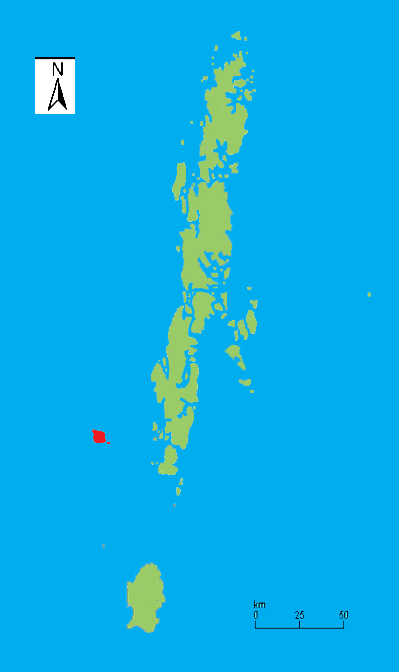The Most Isolated People in the World

The part of the Indian Ocean encapsulated by the eastern shore of India and the shores of Bangladesh and Myanmar (Burma) is called the Bay of Bengal. The eastern edge of the Bay of Bengal is defined as a set of islands called the Andaman Islands, an archipelago, most of which are under control of India. North Sentinel Island, a small dot of land, is part of the Andaman Islands. North Sentinel Island is set just west of the larger islands in the group, as seen as the red area in the map at the top. (For further context, the island is flagged on the map here — be sure to zoom in.)
Between 50 and 400 people are estimated to live on North Sentinel Island. These people, known as the Sentinelese, are perhaps the most isolated people in the world and are believed to be pre-Neolithic — literally, technologically in the Stone Age. By and large, the Sentinelese have gone uncontacted by outsiders for centuries if not millennia — in part because the Sentinelese do not take kindly to visitors.
In 1967, Indian authorities began their first meaningful attempt to engage the Sentinelese by leaving coconuts as gifts on the island’s shores. While some progress was made over the course of a few decades, the quality and quantity of contact was minimal at best. Seven years later, anthropologist Trilokinath Pandit and a film crew attempted to woo the Sentinelese into friendly contact with gifts, such as fruit, a pig, some toys, and pots and pans. The result was not positive: a film director was shot in the thigh with an arrow. In the 1990s, India cut off its permission for these anthropological endeavors, citing risks seen in contacting other uncontacted tribes as well as the fear of introducing diseases from mainland India to the Sentinelese people, whose physiologies almost certainly would be ill prepared to recover from.
More recent events strongly buttresses that this decision to cut off hopes of contact is just fine with the Sentinelese. In 2006, a pair of fishermen were plying their trade, illegally, off North Sentinel Island’s shore. Sentinelese archers killed the fishermen. When a helicopter came to recover the bodies, the helicopter too was met with a hail of arrows, and retreated before fulfilling its mission.
What do we know about the Sentinelese? Understandably, very little. They live in huts and are hunter-gatherers, employing the use of javelins, bows and arrows, and harpoons. They speak a language unique to them (also called, by outsiders, “Sentinelese”) which we have no way of translating. The Sentinelese appear to use pig skulls as ornaments of some sort, and have employed the use of red dye in both clothing and what is best guessed to be decoration.
And that, unfortunately, is all we may ever learn. As India has given up almost all hope of making further contact with the Sentinelese, these people are considered autonomous and, in a very real sense, the most isolated people on the planet. It seems like a matter of time before they and their culture die off, becoming a historical footnote. On the other hand, the Sentinelese are resilient — some estimate that they have lived on North Sentinel Island for 60,000 years, and in any event, the Sentinelese somehow survived the Indian Ocean tsunami of 2004 (which probably hit the island).
Bonus fact: Just south of Newfoundland, Canada, are a group of eight small islands collectively known as Saint Pierre and Miquelon. Roughly 7,000 people live there, and no — they’re not aborigines. They’re not Canadians, either. They’re French citizens, inhabiting the only remaining part of New France (the North American colonies of France) which are still under French control. While the islands use the Canadian dollar informally, the official currency is the Euro.
From the Archives: The Tribe of Five: Another group of isolated people, but ones who are quickly dying out.
Related: “The Last of the Tribe: The Epic Quest to Save a Lone Man in the Amazon” by Monte Reel. A similar story — an uncontacted tribe looking to remain that way. In this case, though, the tribe is a tribe of one. Five stars on 11 reviews, available on Kindle.

Leave a comment